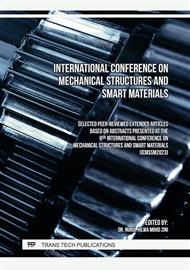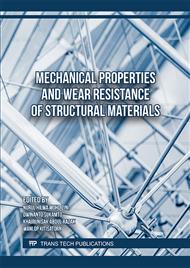[1]
Zhu Y, Cao K, Chen M, Wu L, Synthesis of UV-responsive self-healing microcapsules and their potential application in aerospace coatings, ACS applied materials & interfaces., 11(2019) 33314-22.
DOI: 10.1021/acsami.9b10737
Google Scholar
[2]
Shah S, Ouyang C, Fracture mechanics for failure of concrete, Annual review of materials science, 24(1994)293-320.
DOI: 10.1146/annurev.ms.24.080194.001453
Google Scholar
[3]
Ottosen NS, A failure criterion for concrete, Journal of the Engineering Mechanics Division, 103(1977)527-35.
Google Scholar
[4]
Bin S, Li Z, Multi-scale modeling and trans-level simulation from material meso-damage to structural failure of reinforced concrete frame structures under seismic loading, Journal of Computational Science,12(2016)38-50.
DOI: 10.1016/j.jocs.2015.11.003
Google Scholar
[5]
Vijay K, Murmu M, Deo SV, Bacteria based self healing concrete–A review, Construction and building materials, 152(2017)1008-14.
DOI: 10.1016/j.conbuildmat.2017.07.040
Google Scholar
[6]
Talaiekhozani A, Abd Majid MZ, A review of self-healing concrete research development, Journal of Environmental Treatment Techniques, 2(2014)1-11.
Google Scholar
[7]
Seifan M, Samani AK, Berenjian A. Bioconcrete: next generation of self-healing concrete, Applied microbiology and biotechnology, 100(2016)2591-602.
DOI: 10.1007/s00253-016-7316-z
Google Scholar
[8]
Jonkers HM, Schlangen E. Development of a bacteria-based self healing concrete, Tailor Made Concrete Structures, 1(2008)425-30
DOI: 10.1201/9781439828410.ch72
Google Scholar
[9]
De Belie N, Gruyaert E, Al‐Tabbaa A, Antonaci P, Baera C, Bajare D, A review of self‐healing concrete for damage management of structures, Advanced materials interfaces, 5(2018)1800074.
DOI: 10.1002/admi.201800074
Google Scholar
[10]
Jonkers HM, Self healing concrete: a biological approach, Self healing materials: an alternative approach to 20 centuries of materials science, (2007)195-204.
DOI: 10.1007/978-1-4020-6250-6_9
Google Scholar
[11]
Wang X, Sun P, Han N, Xing F, Experimental study on mechanical properties and porosity of organic microcapsules based self-healing cementitious composite, Materials, 10(2017)20.
DOI: 10.3390/ma10010020
Google Scholar
[12]
Chen PW, Erb RM, Studart AR, Designer polymer-based microcapsules made using microfluidics, Langmuir, 28(2012)144-52.
DOI: 10.1021/la203088u
Google Scholar
[13]
Nishiwaki T, Fundamental study on development of intelligent concrete with self-healing capability, Master's Thesis, 1997.
Google Scholar
[14]
Mihashi H, Kaneko Y, Nishiwaki T, Otsuka K, Fundamental study on development of intelligent concrete characterized by self-healing capability for strength, Transactions of the Japan Concrete Institute, 22(2000)441-50.
DOI: 10.3151/crt1990.11.2_21
Google Scholar
[15]
Sul IH, Youn JR, Song YS, Bubble development in a polymeric resin under vacuum, Polymer Engineering & Science, 52(2012)1733-9.
DOI: 10.1002/pen.23112
Google Scholar
[16]
Hashemi SA, Mousavi SM, Effect of bubble based degradation on the physical properties of Single Wall Carbon Nanotube/Epoxy Resin composite and new approach in bubbles reduction, Composites Part A: Applied Science and Manufacturing, 90(2016)457-69.
DOI: 10.1016/j.compositesa.2016.08.015
Google Scholar
[17]
Afendi M, Banks W, Kirkwood D, Bubble free resin for infusion process, Composites Part A: applied science and manufacturing, 36(2005)739-46.
DOI: 10.1016/j.compositesa.2004.10.030
Google Scholar
[18]
Aaboud B, Saouab A, Park CH, Modeling of air bubble dynamics during resin transfer molding by pore doublet model, The International Journal of Advanced Manufacturing Technology, 105(2019)2343-55.
DOI: 10.1007/s00170-019-04435-1
Google Scholar



